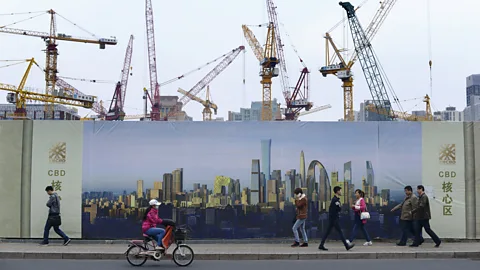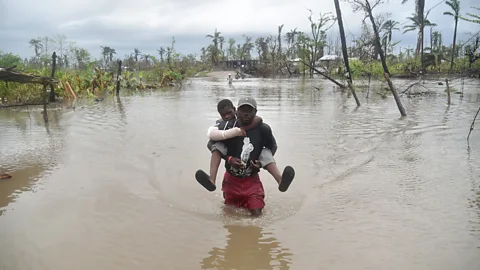12 questions we need to prioritise in 2017
 Getty Images
Getty ImagesIn addition to known global problems such as climate change or poverty, what are the "grand challenges" we face in 2017? We asked a series of experts for their answers.
Grand Challenges
Future Now asked 50 experts – scientists, technologists, business leaders and entrepreneurs – to name what they saw as the most important issues of the 21st Century.
Inspired by these responses, we're publishing a series of feature articles and videos that take an in-depth look at the biggest challenges we face today.
HOW CAN WE AVOID RESISTANCE TO ANTIBIOTICS?
“More needs to be done to improve our ability to diagnose, treat and prevent drug resistant infections and to speed up development of new antibiotics to replace those no longer effective in protecting us against deadly infections. Modern medicine depends on doctors having effective drugs to treat infections. But many common infections are becoming more difficult to treat because bacteria are becoming resistant to the drugs available. Drug-resistant infection – or antimicrobial resistance – is a very serious health threat to us all. Already it results in around 700,000 deaths a year globally. Within a generation it could be 10 million; it could mean we can no longer safely carry out not only complex, lifesaving treatments such as chemotherapy and organ transplants but also more routine operations like caesareans and hip replacements.”
— Tim Jinks, Head of Drug Resistant Infections at Wellcome Trust
 Getty Images
Getty ImagesWHAT CAN WE DO TO CONSERVE WATER — ESPECIALLY IN THE FACE OF CLIMATE CHANGE AND URBANISATION?
“The one major challenge we will face due to urbanisation will be 'water security'. We are already grappling with this problem across our developing member countries and with deteriorating river or surface water quality, lack of sufficient ground water sources and increasing dependence on sea water as a supply source. We have to bring in innovations in water management. Treatment technology, water aquifer mapping, recycling and reuse of wastewater, and more are areas of R&D investment.”
— Vijay Padmanabhan, Asian Development Bank, Technical Advisor (Urban)
HOW DO WE FIGHT ‘FAKE NEWS’?
“The fundamental challenge we now face is how to handle a setting where anybody can get their views disseminated without intermediaries to prevent the distribution. Somehow there still has to be some process of collectively coming to some agreement of what we are going to believe and what we think are consensual facts. A lot of what I have seen in terms of approaches to deal with that are trying to do things that are focused on assessing the content of factual claims to try to verify whether they are true or not. I don’t think that at its heart will be the mechanism. I think that it is going to be not figuring what to believe but who to believe.
“Most individuals can’t personally verify most factual claims that we hear. If you think about some of the things you personally believe that are fact, there are many that you have not personally verified. It would be tremendously inefficient for all of us to try to personally verify all of these things. We have to have a setting where we trust other people.”
— Paul Resnick - professor of information at the University of Michigan
Discover more:
IN AN INTERCONNECTED WORLD, HOW DO WE FIGHT GLOBAL DISEASE?
“Vast amounts of international travel, increasing urbanisation and a changing climate means that viruses can cross borders and spread around the globe faster than ever before. Recent outbreaks like SARS, Ebola and Zika have all shown how unprepared the world is to deal with epidemics. To stand any chance of tackling this threat, we need new vaccines, stronger healthcare systems and a better coordinated global response. At Wellcome, we’re working to address this threat in a variety of ways; we are a founding partner of the Coalition for Epidemics Preparedness Innovations (CEPI) that will develop new vaccine candidates against infections we know could cause a serious epidemic. The WHO also needs to be much better funded and have the mandate to respond swiftly and effectively when diseases do begin to spread. Only by investing, coordinating and working together can we expect to prepare the world for the next inevitable epidemic.”
— Mike Turner, Head of Infection and Immunobiology at Wellcome Trust
“First, many countries have weak national systems for detecting and responding to outbreaks. Second, we have too few vaccines, medicines, and diagnostics for emerging infectious diseases with outbreak potential. Third, at the international level, we simply don’t yet have a robust, joined-up approach to providing the essential components of a preparedness and response system – like surge capacity in producing vaccines in a crisis, an interconnected global surveillance system, or a global reserve corps of emergency responders. Closing these three gaps is one of the most urgent global priorities if we are to avert a potential world catastrophe. For example, if we suffer another flu pandemic similar to the 1918 ‘Spanish flu,’ the World Bank estimates that there could be 71 million deaths and a global recession costing over $3 trillion.”
— Gavin Yamey, professor of the practice of global health, Duke University Global Health Institute
 Getty Images
Getty Images“The recent Ebola and Zika epidemics exposed our global vulnerabilities to deadly microbial threats and highlighted the need for proactive measures in advance of outbreaks and swift action during them. At the same time, it shows our ability to prevent, diagnose, and treat deadly infectious diseases through new technologies. It is a time of great potential for devastation or advancement for one of the greatest challenges of our lifetimes.”
— Pardis Sabeti, Associate Professor of Organismic and Evolutionary Biology and of Immunology and Infectious Diseases, Harvard University
Discover more:
HOW WILL WE DEAL WITH OVERPOPULATION?
“Technological improvements, while potentially important in reducing the per capita impact [of climate change], are not sufficient to make us sustainable unless we also stop growth in human numbers and reduce average consumption, while simultaneously lessening the gap between the richest and the poorest people on the planet. So far, non-renewable resources are what primarily drive our economic engine. But by definition, non-renewables are being depleted and for the most part will stop being economically available in this century. So we must plan rapidly for the day when humanity can live using just renewable resources, while maintaining the biodiversity that makes the planet habitable.”
— William Ryerson, founder and president, the Population Institute and Population Media Center
HOW WILL THE ERA OF BIG DATA AND ARTIFICIAL INTELLIGENCE SHAPE OUR HEALTH?
“Our major challenge is related to our new capability of digitising human beings. That is, via biosensors, DNA sequencing and imaging, we can define each individual’s medical essence. But the problem is that this generates many terabytes of data, which includes real-time streaming of key metrics like blood pressure. Aggregating and processing the data, derived from many sources, with algorithms and artificial intelligence (particularly deep learning) is a daunting task. Once we can do this, we’ll be on our way to a virtual medical coach – your smartphone providing instantaneous feedback on all your health and medical metrics to help prevent you from getting sick.”
— Eric Topol, Scripps Transatlantic Science Institute
HOW CAN WE SAFELY USE GENE EDITING TECHNOLOGY IN HUMANS?
“As a co-inventor of CRISPR-Cas9 gene editing technology, I am delighted to see that this groundbreaking ability to ‘cut and paste’ genes so efficiently is being harnessed as a strategy to create new food, therapeutics, materials and methods for controlling the spread of disease. A challenge moving forward is how best to engage the public with this fundamental science that really can positively impact human life and the world we live in. I believe that we must continue to discuss and consider the profound societal and ethical impacts of CRISPR technology and ensure that it is not abused.”
— Jennifer Doudna, professor of Molecular and Cell Biology and Chemistry at the University of California, Berkeley, co-inventor of CRISPR-Cas9 technology
“Recent advances in gene editing suggest a future in which we can radically upgrade human genomes. We might use tools to rewrite genes that influence traits such as intelligence and lifespan. We should bear in mind when we contemplate this enhanced future that the obvious answers aren’t always the right ones. The human genome isn’t something we should seek to build a wall around, protecting it from all change. But a rush to enhance ourselves may erase aspects of our humanity that proper reflection reveals as valuable. More IQ points aren’t better than fewer in the straightforward way that more money is better than less. We risk oversimplifying what’s involved in enhancement. Proper reflection on what about us we might want to preserve takes time – it should draw on a wide range of perspectives about what it means to be human. It’s difficult to set aside this time for ethical reflection when new technological possibilities seem to be coming thick and fast.”
— Nicholas Agar, professor of ethics at the Victoria University of Wellington
 Getty Images
Getty ImagesHOW DO WE MAKE CITIES MORE SUSTAINABLE AND PLEASANT FOR THE PEOPLE WHO LIVE THERE ?
“Virtually every neighbourhood in the US has a neighbourhood organisation – 30 years ago this didn’t exist. The issue is coming up with software that will create a mega database that will understand every part of the built environment at the place level, and eventually, the metropolitan level. Right now, nobody knows what’s in Midtown [Manhattan]. We don’t know what percentage of that is office; what percentage of that is retail. We didn’t have those data sets 15 years ago, and we didn’t have the software, and we certainly didn’t have the computing capability.
So when a city or when a business improvement district makes a major capital investment in the future, you could foresee the time that we’ll be able to say, ‘okay, let’s build the Second Avenue subway. It’ll cost us $5bn and this is the expected economic and tax revenues we will get from that based on this data set, and we will then decide what to do – and we will look at secondary consequences like gentrification and see how we’re going to address that based upon those future projects we make.’ We will learn much better how to plan, build, and pay for these places; invest in the right thing. Right now conclusions are based on guestimations, like ridership. We’re getting closer to saying this is going to be the economic and fiscal benefit of doing that, and here are the unintended consequences we need to be concerned about: congestion, gentrification, or displacement, whatever. All those tools will help place managements. This is a new field of place management.”
— Chris Leinberger, Nonresident Senior Fellow - Metropolitan Policy Program, Brookings Institute
“The battle for sustainable development will be won or lost in cities. 150 million people are moving to cities each year. By 2050, over 7 billion people will live in cities (80% of the world), and cities will be responsible for 75% of global carbon emissions. Cities are places where infrastructure gets locked in for decades, if not centuries, but city planners must make investments now in a world where technology is changing rapidly where people live, work and play, and how they access buildings, transport, energy and waste management. The fastest growth is happening in thousands of secondary cities where mayors and city managers are not well schooled in technical urban planning. Often, these secondary cities must collaborate with each other to deliver services effectively across boundaries within larger metropolitan areas.”
— Homi Kharas, senior fellow and deputy director of Brookings Institute’s Global Program
"Climate Change exacerbates the challenges thrust upon impoverished people. The use and habitation of spaces demonstrates this clearly – the quantity, quality, and increasingly, the ability of one’s space to protect from harsher and unexpected elements. Solutions should be structural as well as grassroots: sound policy as well as micro-local community-based.
Scratching the surface are programmes offered by governments and utilities, to assist homeowners to weatherise their structures. Impoverished communities still lack the resource and capacity to capture full use of technologies – methods are already known and commonplace in sustainable new construction. The most robust and innovative energy efficiency programs are yet to benefit those that would feel the greatest impact from the captured savings."
— Nootan Bharani, Lead Design Manager, University of Chicago's Place Lab
HOW CAN WE KEEP EXTENDING OUR LIFE EXPECTANCIES?
“Recent research has shown that a country’s ratio of health to social service spending is predictive of some key health outcomes, like life expectancy, infant mortality, and maternal mortality. Genetics and health care play a role, but social, environmental, and behavioural factors have far greater impact on the whole health of a population. Some examples of social service investments include job training, supportive housing, and nutritional support – all of which have traditionally had an underestimated focus of attention.”
— Elizabeth Bradley, Professor of Grand Strategy, Head of Branford College, Professor of Public Health and Faculty Director of the Yale Global Health Leadership Institute
HOW CAN RAPIDLY DEVELOPING REGIONS GROW EFFECTIVELY?
“The majority of Africans will live in towns and cities by 2050. Management consultancies and international financiers routinely claim that rapid urbanisation is one of the great pluses in the investment case for Africa. As things stand, this is hyperbolic nonsense. For towns and cities to drive economic growth and livelihood improvement, more imaginative and effective urban planning and management are imperative; and the provision of public goods must replace a narrow focus on the wellbeing of elites.
Firstly, citizens have to be involved. Community participation in slum redevelopment initiatives has proven to be a far more productive and cheaper way of going about things than imposing ill-conceived, expensive schemes from above. Secondly, the technology exists to facilitate the rapid planning required – for example, data collection with mobile phones and satellite imagery have already been beneficial. Thirdly, urban-dwellers everywhere – voters – can mobilise even more effectively to ensure that their elected representatives deliver more. The final, essential, component is political will. This has been conspicuously lacking, but more determined and competent mayors and city leaders are emerging and the power of example is considerable.”
— Edward Paice, Director, Africa Research Institute
 Getty Images
Getty ImagesHOW CAN WE BETTER INFORM PEOPLE ABOUT NATURAL DISASTERS?
“We do a great job as a society of funding and supporting innovative research – we really admire that aspect of it. What we do a very bad job at is making the interface between that esoteric research and how people can actually use the information. People want predictions (for earthquakes). But people have to understand the scientific process. That’s problem number one: the communication phase. People on the outside turn to us (researchers) for answers, and we are so caught up in the scientific process that we know no answer that we’re talking about is final. There’s this gap that we’re not helping people understand, and it’s actively discouraged – if you have a young scientist who’s brilliant on TV explaining earthquakes, they may say no, I’m not going to do this because it’s going to hurt my career.”
— Lucy Jones, Science Advisor for Risk Reduction for the United States Geological Survey
CAR OWNERSHIP CONTINUES TO RISE WORLDWIDE — HOW WILL WE ACCOMMODATE THIS?
“Whatever technology may accomplish, we will still need to think about how space [in cities] is used: automated and ride-sharing vehicles take up as much room as regular cars, whether they're on the road or parked off the street. Going into the future, urban space still needs to be designed to maximise places for people to congregate, which are key to building social connections, fostering a sense of belonging, and encouraging community efficacy. Space for human connection is often not considered at all against technological solutions in cities. Not nearly enough attention is given to the social impacts of these new solutions – we must carefully consider how they may change the physical shape and design of our cities in the future. Most importantly, we must be aware of how they might isolate us. After all, by limiting our ability to socialise, technology may only generate new problems to replace the ones it ‘solved’.”
— Shin-pei Tsay, Executive Director, Gehl Institute
"According to the World Health Organisation, over 1.2 million people a year die from crashes on the world’s roadways. This is epidemic in scale. Traffic safety experts predict that over 90% of roadway fatalities can be eliminated when driverless vehicle technology reaches its full potential. Regulators, police organisations and liability experts responsibly caution that we cannot let driverless technology get in front of safety. However, like with all epidemics, we also have a responsibility to realise the full potential of cures as soon as possible. While we must be prudent, we also must not let those with vested interests in human driven cars slow progress. We must work together to safely accelerate the realization of driverless vehicles. Reaching this imperative one day sooner could save over 3,000 lives!"
— Larry Burns, former corporate vice president of Research and Development for General Motors
-
If you liked this story, sign up for the weekly bbc.com features newsletter, called “If You Only Read 6 Things This Week”. A handpicked selection of stories from BBC Future, Earth, Culture, Capital, and Travel, delivered to your inbox every Friday.
